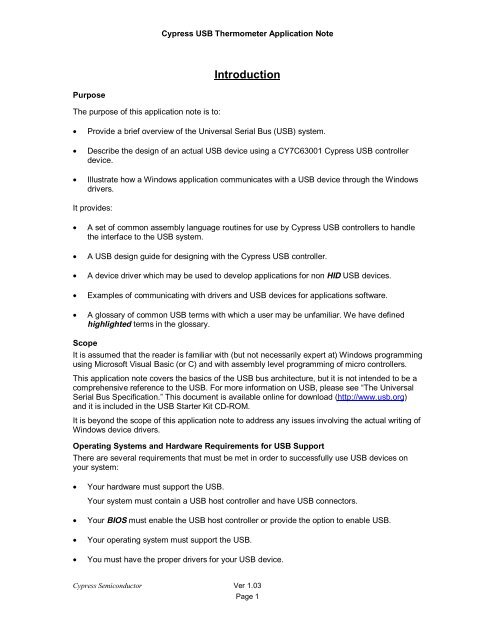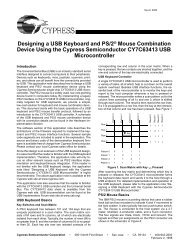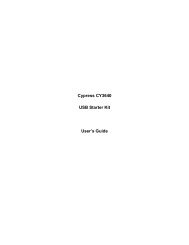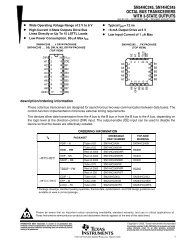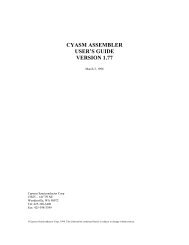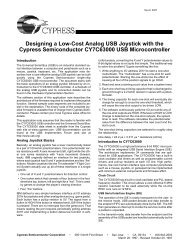Designing a Universal Serial Bus (USB) Device Using the Cypress ...
Designing a Universal Serial Bus (USB) Device Using the Cypress ...
Designing a Universal Serial Bus (USB) Device Using the Cypress ...
Create successful ePaper yourself
Turn your PDF publications into a flip-book with our unique Google optimized e-Paper software.
<strong>Cypress</strong> <strong>USB</strong> Thermometer Application Note<br />
Introduction<br />
Purpose<br />
The purpose of this application note is to:<br />
• Provide a brief overview of <strong>the</strong> <strong>Universal</strong> <strong>Serial</strong> <strong>Bus</strong> (<strong>USB</strong>) system.<br />
• Describe <strong>the</strong> design of an actual <strong>USB</strong> device using a CY7C63001 <strong>Cypress</strong> <strong>USB</strong> controller<br />
device.<br />
• Illustrate how a Windows application communicates with a <strong>USB</strong> device through <strong>the</strong> Windows<br />
drivers.<br />
It provides:<br />
• A set of common assembly language routines for use by <strong>Cypress</strong> <strong>USB</strong> controllers to handle<br />
<strong>the</strong> interface to <strong>the</strong> <strong>USB</strong> system.<br />
• A <strong>USB</strong> design guide for designing with <strong>the</strong> <strong>Cypress</strong> <strong>USB</strong> controller.<br />
• A device driver which may be used to develop applications for non HID <strong>USB</strong> devices.<br />
• Examples of communicating with drivers and <strong>USB</strong> devices for applications software.<br />
• A glossary of common <strong>USB</strong> terms with which a user may be unfamiliar. We have defined<br />
highlighted terms in <strong>the</strong> glossary.<br />
Scope<br />
It is assumed that <strong>the</strong> reader is familiar with (but not necessarily expert at) Windows programming<br />
using Microsoft Visual Basic (or C) and with assembly level programming of micro controllers.<br />
This application note covers <strong>the</strong> basics of <strong>the</strong> <strong>USB</strong> bus architecture, but it is not intended to be a<br />
comprehensive reference to <strong>the</strong> <strong>USB</strong>. For more information on <strong>USB</strong>, please see “The <strong>Universal</strong><br />
<strong>Serial</strong> <strong>Bus</strong> Specification.” This document is available online for download (http://www.usb.org)<br />
and it is included in <strong>the</strong> <strong>USB</strong> Starter Kit CD-ROM.<br />
It is beyond <strong>the</strong> scope of this application note to address any issues involving <strong>the</strong> actual writing of<br />
Windows device drivers.<br />
Operating Systems and Hardware Requirements for <strong>USB</strong> Support<br />
There are several requirements that must be met in order to successfully use <strong>USB</strong> devices on<br />
your system:<br />
• Your hardware must support <strong>the</strong> <strong>USB</strong>.<br />
Your system must contain a <strong>USB</strong> host controller and have <strong>USB</strong> connectors.<br />
• Your BIOS must enable <strong>the</strong> <strong>USB</strong> host controller or provide <strong>the</strong> option to enable <strong>USB</strong>.<br />
• Your operating system must support <strong>the</strong> <strong>USB</strong>.<br />
• You must have <strong>the</strong> proper drivers for your <strong>USB</strong> device.<br />
<strong>Cypress</strong> Semiconductor Ver 1.03<br />
Page 1


